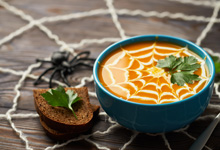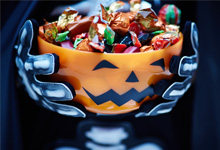
Halloween is designed to terrify us. The ghouls! The goblins! The attempts to teach children about portion control while they’re holding pillowcases stuffed with candy!
Thankfully, Meghan Gonzalez, R.D., C.D.C.E.S, a Hoag registered dietitian and certified diabetes care and education specialist is here to allay parents’ fears of the things that go bump (and crinkle, and crunch and slurp) in the night.
|
 Plan ahead. “Prepare a nice, healthy meal of high-fiber foods before hitting the neighborhood for trick-or-treating,” Gonzalez said. “Filling up with fiber slows digestion and helps to ensure that most of what a child eats on Halloween night will be nutritious.” Plan ahead. “Prepare a nice, healthy meal of high-fiber foods before hitting the neighborhood for trick-or-treating,” Gonzalez said. “Filling up with fiber slows digestion and helps to ensure that most of what a child eats on Halloween night will be nutritious.”
|
|
 Let them eat candy. “Forbidding children to eat candy and sweets will contribute to making these foods more desirable and appealing and may lead to them sneaking it,” said Gonzalez. “By allowing them to have the candy alongside other foods they usually eat, the novelty goes away. It is important to help your child develop a healthy relationship with food by offering sweets and candy with structure and support. Give them guidelines as to how much to eat and when. This is a great opportunity to educate your children about candy having no nutritional value but how it can be included with healthy foods as part of a well-balanced diet.” Let them eat candy. “Forbidding children to eat candy and sweets will contribute to making these foods more desirable and appealing and may lead to them sneaking it,” said Gonzalez. “By allowing them to have the candy alongside other foods they usually eat, the novelty goes away. It is important to help your child develop a healthy relationship with food by offering sweets and candy with structure and support. Give them guidelines as to how much to eat and when. This is a great opportunity to educate your children about candy having no nutritional value but how it can be included with healthy foods as part of a well-balanced diet.”
|
|
 Turn it into math. Candy is colorful, small and fun-looking. “Lead kids in activities like sorting, counting, graphing, pattern-making and (my favorite) trading,” Gonzalez said. “There are few foods so fun to look at and manipulate as candy. It’s a perfect opportunity to turn a pile of sugar and food coloring into an activity that is actually good for your brain!” Turn it into math. Candy is colorful, small and fun-looking. “Lead kids in activities like sorting, counting, graphing, pattern-making and (my favorite) trading,” Gonzalez said. “There are few foods so fun to look at and manipulate as candy. It’s a perfect opportunity to turn a pile of sugar and food coloring into an activity that is actually good for your brain!”
|
|
Haunted by more questions about Halloween candy? Call your pediatrician or check out www.hoaghealth.org.
|



 Plan ahead. “Prepare a nice, healthy meal of high-fiber foods before hitting the neighborhood for trick-or-treating,” Gonzalez said. “Filling up with fiber slows digestion and helps to ensure that most of what a child eats on Halloween night will be nutritious.”
Plan ahead. “Prepare a nice, healthy meal of high-fiber foods before hitting the neighborhood for trick-or-treating,” Gonzalez said. “Filling up with fiber slows digestion and helps to ensure that most of what a child eats on Halloween night will be nutritious.” Let them eat candy. “Forbidding children to eat candy and sweets will contribute to making these foods more desirable and appealing and may lead to them sneaking it,” said Gonzalez. “By allowing them to have the candy alongside other foods they usually eat, the novelty goes away. It is important to help your child develop a healthy relationship with food by offering sweets and candy with structure and support. Give them guidelines as to how much to eat and when. This is a great opportunity to educate your children about candy having no nutritional value but how it can be included with healthy foods as part of a well-balanced diet.”
Let them eat candy. “Forbidding children to eat candy and sweets will contribute to making these foods more desirable and appealing and may lead to them sneaking it,” said Gonzalez. “By allowing them to have the candy alongside other foods they usually eat, the novelty goes away. It is important to help your child develop a healthy relationship with food by offering sweets and candy with structure and support. Give them guidelines as to how much to eat and when. This is a great opportunity to educate your children about candy having no nutritional value but how it can be included with healthy foods as part of a well-balanced diet.” Turn it into math. Candy is colorful, small and fun-looking. “Lead kids in activities like sorting, counting, graphing, pattern-making and (my favorite) trading,” Gonzalez said. “There are few foods so fun to look at and manipulate as candy. It’s a perfect opportunity to turn a pile of sugar and food coloring into an activity that is actually good for your brain!”
Turn it into math. Candy is colorful, small and fun-looking. “Lead kids in activities like sorting, counting, graphing, pattern-making and (my favorite) trading,” Gonzalez said. “There are few foods so fun to look at and manipulate as candy. It’s a perfect opportunity to turn a pile of sugar and food coloring into an activity that is actually good for your brain!”






